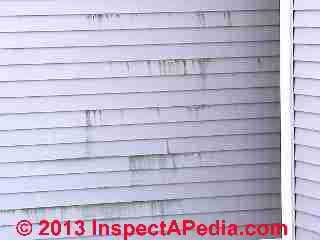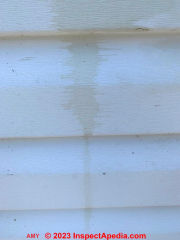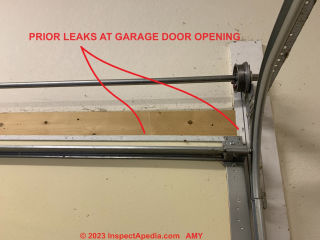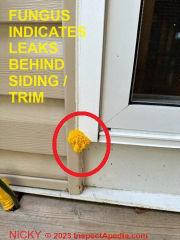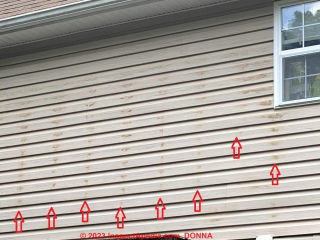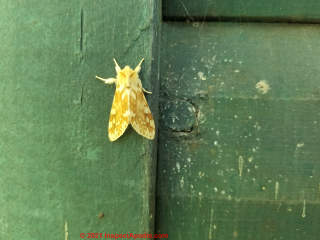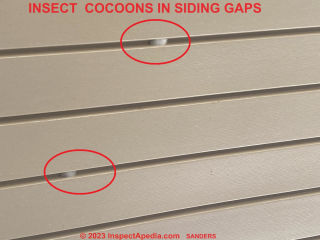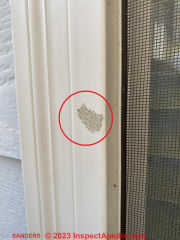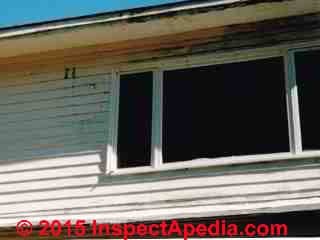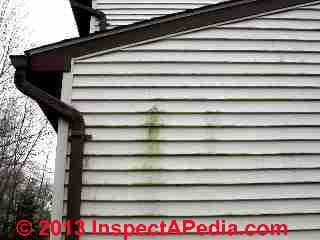 Causes of Vinyl Siding Stains
Causes of Vinyl Siding Stains
Algae, Lichens, Soot, Other Marks
- POST a QUESTION or COMMENT about Vinyl Siding on Buildings, Installation, Inspection Methods, Defects, Diagnosis & Repai
Vinyl siding stain diagnosis:
This article discusses common causes of stains or discoloration found on vinyl building siding. Distinguishing the type of stain found on siding is useful in deciding on the cause and thus the cure or prevention of staining.
Dirt from rain splash-up, algae, lichens, mold, moss, or even smoke or chemical stains have different causes and different preventative measures.
Shadows, moisture variations that collect or don't collect dust on siding, even roof leaks or air leaks through building walls can often be diagnosed by a close look at wall stain patterns discussed here.
InspectAPedia tolerates no conflicts of interest. We have no relationship with advertisers, products, or services discussed at this website.
- Daniel Friedman, Publisher/Editor/Author - See WHO ARE WE?
Stains on Vinyl Siding: Algae, Fungus ("Mildew"), Artillery Fungus, Smoke, Dirt, Leaks
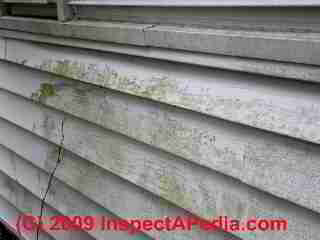
As we complain throughout InspectAPedia.com, mildew, a proper subset of the larger family of molds or fungi, does not grow on buildings - mildew grows on living plants.
But people often refer to mold growth on surfaces as "mildew" and so product manufacturers selling cleaners intended to remove mold will understandably call them "mildew removers". It's mold - if you care.
The photo at above left shows green algae on vinyl siding. Algae may also look black or brown, as may some molds.
[Click to enlarge any image]
Small gray or darker round spots on siding that are about 1/16" in individual diameter, particularly if the spots are slightly raised may be artillery fungus - a mold spore. [Photo below]
Other larger spots, 1/8" or so but with the same properties may be remaining footprints from vines that were growing on the wall.
Algae on building walls:
Algae is often confused with mold. In our photo above we see a common condition that is found on many types of building siding: green (or brown or black) algae growth.
Algae is found on vinyl siding as well as many other building surfaces that are shaded and stay damp.
 While algae stains on exterior walls are principally a cosmetic concern and can be cleaned using scrubbing, mild soaps, or more aggressive TSP-substitute cleaners or detergents, there may remain a hidden problem: any building wall that stays damp and shaded may be at higher risk for hidden insect or rot damage.
While algae stains on exterior walls are principally a cosmetic concern and can be cleaned using scrubbing, mild soaps, or more aggressive TSP-substitute cleaners or detergents, there may remain a hidden problem: any building wall that stays damp and shaded may be at higher risk for hidden insect or rot damage.
If there is an accessible crawl space or basement below a wall that looks like the one in our photo, that's a good place to look for signs of building leaks, rot, or insect damage.
In our photo just above we think these black specs may be a fungal growth.
A pen cap is included in the photo for scale.
Artillery fungus can produce black specs on a building wall, trim, or other outdoor surfaces. Similar black specs may be found on exterior siding where the attachment points of vines have adhered to the surface.
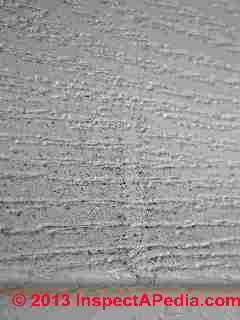
In our photo at above you are looking at dirt and dust on building siding; that vertical light colored streak shows where water has washed away some of the surface debris.
"Is that a problem?" is a common question.
Probably not. Look above the water streak for a drain opening that is permitting condensate to drain off from the back side of the building siding ouit onto the siding exterior surface. Such markings may be normal.
But extensive water streaks down exterior siding [photo above] may indeed indicate a wall or roof leak that needs to be tracked down and repaired.
Our photo shows that water has been leaking out of this vinyl-clad wall (in winter in a northern climate); further investigation and repair are needed, and there is a risk of hidden rot damage, insect damage, or mold contamination in the wall cavity; I'd also worry that water leaking into the wall cavity may have wet insulation.
Advice for Dealing with Algae or Mold on Outside Walls
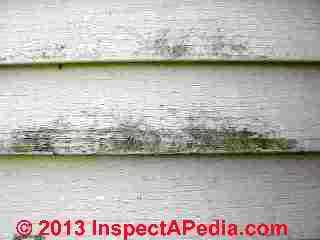 The black stains on the vinyl siding shown at left may be a fungus or a black agae: by the growth pattern we think this is almost certainly a dark-colored algae.
The black stains on the vinyl siding shown at left may be a fungus or a black agae: by the growth pattern we think this is almost certainly a dark-colored algae.
A microscopy lab examination of a sample from this surface would be needed to know for sure. But testing is probably not justified.
Where there are apparent "growth" substances on a building exterior wall we offer the following added advice:
- The same cleaning methods - soap and water, or stronger cleaners - work pretty well on either mold or algae on a building wall
- Skip testing:
Testing to identify the material by collecting a lab sample is easy and not very costly ($25 to $50. typically) but in general we do not recommend this step.
It's not necessary before cleaning off the mold or algae, and except for the presence of mold or algae on a wall as an indicator of damp conditions, exterior building molds or algae are not a threat to building occupants except in very rare circumstances.
If you insist on testing anyway,
see TEST KIT for DUST, MOLD, PARTICLES: INSTRUCTIONS - Fix the cause of wall mold or algae:
if you don't want recurrent mold or algae growth on a building wall it needs to be more dry and to receive more sunlight. We hate cutting down mature trees, but don't hesitate to trim back dense shrubs close to a building exterior wall. - Increase mold/algae resistance of your exterior wall
if it's a wood wall that's being stained or painted - by using a fungicidal additive to your paint or stain.
Obviously this isn't going to be of use siding materials that are not going to be painted.
...
Reader Comments, Questions & Answers About The Article Above
Below you will find questions and answers previously posted on this page at its page bottom reader comment box.
Reader Q&A - also see RECOMMENDED ARTICLES & FAQs
On 2023-08-12 by InspectApedia Publisher (mod) - Diagnostic key to these siding stains:conditions behind the siding & on the siding back surface
@Amy,
From exploring even a single area of siding staining in this manner we can know for sure
if the stains are leaching from behind the siding (leaks and water penetratin + a stain source house wrap or sheathing)
or if they are entirely caused by something that spilled-on or was applied to the exterior surface (no stains on the siding back side).
What makes this investigation easier is using a siding removal tool -that lets us pop off vinyl siding without damaging it and so that it can also be snapped back in place.
See
VINYL SIDING HOOK to REMOVE & REPLACE
Do keep us posted and post photos of what you are seeing.
On 2023-08-12 by Amy - further siding exploration to be done
@InspectApedia Publisher,
Thanks for the input. I will definitely try to get that done. When I do, I’ll report back and let you know what they find!
On 2023-08-11 by InspectApedia Publisher (mod) - need to inspect behind a representative sample of stained vinyl siding
@Amy,
A home built in 2005 in the U.S. would not be expected to use asphalt-impregnated felt as a house-wrap (though it's of course possible) so that common stain source is not so likely.
But I suspect that leaks behind the siding have leached out oils from plywood or OSB sheathing or other wall components.
While the stains are a cosmetic annoyance, in my OPINION the more significant worry is the risk of more hidden damage, rot, insect attack, from the leaks that caused the rot that you reported.
So if no one has ever investigated the condition of the wall framing and sheathing behind the siding, I think that's in order.
Removing and replacing siding isn't technically-difficult. I'd have some siding removed starting just above the highest leak / stain you see on the wall - let's see what's going on inside.
If the work to remove the siding is done using a siding removal tool to un-clip siding sections that can be done without ruining the siding materials themselves - in case you end up wanting to re-use it.
On 2023-08-11 by Amy - stains on vinyl siding in "mid south US"
@InspectApedia Publisher,
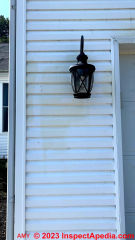
The home was built in 2005. It is in the Midsouth US.
I’ve tried a bleach solution, a simplegreen solution, pressure washing with simplegreen, and a combo of Tilex + a magic eraser. That last combo was the most effective as far as lightening the stain goes, but it didn’t remove it, and the stain did darken again with the rise in temperature.
This is the only spot on the house where there’s staining. There is other evidence of leakage; the 2x4 beam that frames out the top of the garage door opening was rotted out when we moved in. A contractor replaced that beam (image of new one attached).
From things I read on the internet, the 2x4 being not sealed or dried out could cause sap to leak from the wood? So maybe it’s sap? I don’t know.
On 2023-08-10 by InspectApedia Publisher (mod) - key diagnostic on siding stains: highest point at which the stain begins
@Amy,
I've looked at your photos several times and am sorry to say I'm still uncertain about the cause and thus cure of those stains.
From what I can see there could be leaks - such as wind-blown rain - entering behind the siding, leaching out a color from building siding or, if roofing felt was used as a housewrap, from that material.
Your closeup picture (above) also suggest an oily stain material - the color and the way the stain tends to bleed in a horizontal pattern in the grain of the vinyl siding texture.
The key diagnostic element that I can not see in your photo above is the highest point at which the stain begins - the highest point. If that point originates at a siding gap or joint between two siding sections then I think the stain is coming from behind the siding.
But if a siding stain originates towards the center of a siding "board" or segment then I think the origin of the stain is from the building exterior - not a leak behind the siding.
Do these stains occur only on this side of the home?
What are the age and location of the home?
Do you have any photos of its exterior walls during construction that might show the housewrap?
What cleaners have you tried?
On 2023-08-09 by Amy
Hello! A few summers back, these stains showed up around our garage door (interior view above).
No cleaning agents I’ve tried have been successful at removing them. They definitely look worse in the summertime. What do I do?
On 2023-07-05 by InspectApedia Publisher (mod) - mushrooms growing out of exterior wall or trim mean leaks behind the wall or trim
@Nicky,
That sure looks like the fruiting body of a fungus - something we'd find growing out of a wall when there has been a water leak at that point. I'd look for a leak at the top or along the side of the window. There could also be a leak along the bottom of the vinyl window sill itself.
There's very likely some wet insulation and some mold growth in the wall cavity at that location.
You might also check inside for water stains, mold odors, and for moisture using a moisture meter. (That's not an exhaustive test but worth doing). In the worst case you'd want to cut open the drywall from inside to remove wet materials, dry the area, and, before completing the repair you'd be sure that the leak outside has been found and fixed.
On 2023-07-05 by Nicky
This substance appeared on the side of my patio door overnight and looks like it's coming out from behind the trim / siding. Any idea what this could be? It was most definitely not there yesterday and was a bit alarming when I found it this morning. tks very much
On 2023-05-31 by InspectApedia DF (mod)
@Donna,
Glad to be of help. We always appreciate that readers find out website useful as we've spent decades on this material.
We welcome any additional questions, comments, criticisms, or suggestions.
On 2023-05-31 by Donna
@InspectApedia DF, thank you for the response. I hadn’t found anything similar prior to posting. Your information was very helpful and ironically I have the same trees along my house as the prior example. I get to work cleaning it.
On 2023-05-30 by InspectApedia DF (mod) - stains on exterior wall track location of wall studs or framing
@Donna,
On this page,
STAINS ON BUILDING EXTERIORS
You will see a photo of a home in British Columbia that looks very similar to your image with the regularly spaced lines of stain vertically down the siding. It is a classic example of the combination of thermal bypass temperature variations marking the locations of studs in a wood framed exterior wall.
Notice by the red arrows that we added to your photo that the stain splotches occur in regular vertical columns that are spaced apart about 16 inches - typical wall stud framing interval.
Watch out: when we see thermal tracking stains on the outside of a building like this and if we think that the building walls were probably insulated, I worry that leaks into the wall, perhaps from roof leaks or ice dams, have wet the insulation so that it has lost its insulating value.
If that's found to be the case, there is also a risk of hidden mold contamination or other water-related damage such as insect attack.
So it's worth making a test opening into the wall in this area to see what conditions are found.
After taking a look at that article, please let us know if you have additional questions.
On 2023-05-30 by Donna
My west facing wall has these mostly uniform markings. Not found elsewhere on the house. My concern is if water is getting behind the siding. There are some tall shrubs and a roof under the area. Very well hidden ends of the wall do not have these markings.
On 2023-01-16 by InspectApedia Publisher (mod) - stains on vertical trim at window?
@Sue Sanborn,
I cannot make out vinyl siding in your photo, instead it looks like building exterior work that's incomplete or has been ripped off.
If in fact no building trim covering has been lost then I think there have been leaks behind the trim and along its edges, perhaps from improperly-installed J-channel over that window.
Check also for signs of water leaks into the wall below this window. If necessary, pulling off floor trim or window sill trim or even making a small test cut into the wall can tell us if the wall cavity and its insulation have been wet or perhaps mold contamianted.
On 2023-01-16 by Sue Sanborn
What is this on my vinyl siding? This is the only place I notice this.
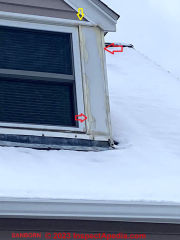
On 2023-04-10 by danjoefriedman (mod) - Two types of insect eggs found on building exteriors
@Anonymous, thank you for the question and the photo of a white cottony item on your siding.
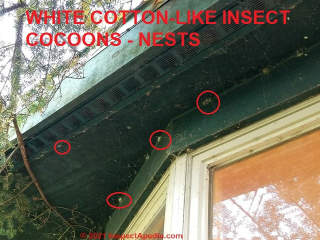
These white cotton-like cocoons are egg sacs that harbor caterpillars, spiders, or other insects - but not those tiny black dot insect eggs in your earlier photo.
We often see these cocoons on buildings where insects over-winter and emerge in the spring, leaving their cottony nests behind.
Actually where I've opened or smashed those white cotton-like insect cocoons I've usually found insect larvae inside. They do hatch, the insects emerge, but the empty web cluster material will often remain until it's mechanically scrubbed off.
When you see a white cotton like insect cocoon on building siding it can be any of a number of insect species; some common ones include
Antheraea polyphems
Lophocampa caryae
Orgyia sp. - very common on building exteriors
Orgyia detrita - fir tussock moth
Plaster bagworms - building interiors, esp. in warm humid areas eg in the U.S., Florida
My photo above shows a collection of these white cotton-like cocoons/nests on a cabin in northern Minnesota.
Below on the same building in spring weather in 2020 we have a yellow, adult moth
On 2023-04-10 by Sanders - white fluffy objects on exterior siding
@danjoefriedman,
The weird thing is they never hatch or change. If they were eggs wouldn’t they hatch and go away/change? We also have this white stuff now as well. Any idea on it? It is on the ceiling of the patio as well.
On 2023-04-03 by danjoefriedman (mod)
@Sanders, that looks like a cluster of insect eggs. If you remove these insect eggs and see new ones it's probably because the parent insects are still around or are returning to put more eggs on your building. I've seen these from stink bugs and other insect genera/species.
On 2023-04-03 by Sanders - round dot or circular deposits on exterior siding
Any idea what this is or what is causing it?
The black is like tiny perfect circles in different shapes and it is all over our house on hardy plank, windows and the patio ceiling, but the patio ceiling has the most.
We can Clean it with Clorox and it goes away, but it always comes back and now we have this white furry stuff growing as well on the covered patio ceiling.
Reader Question: Chalking surface of older vinyl siding - is this normal
I am wondering why when I rub my fingers across our siding I come away with my fingers being white.
Is this a normal vinyl siding thing or does it mean it has been previously painted or what? I want to clean the siding but would like to know what the white stuff is first. - Anon 8/18/2011
Reply:
Anon,
Yes indeed, some formulations of vinyl siding, especially some older products, will oxidize, producing a dull or powdery film of oxidized material similar to paint chalking.
This appears especially on building areas exposed to the most sunlight. If the siding is not cracking and breaking then it's a cosmetic defect not a functional one, but it is also an indication of siding age, formulation, and sunlight exposure. If your white stuff correlates with weathering or sun exposure then the white stuff is most likely oxidized vinyl.
Watch out: any older oxidized plastic may have increased in brittleness and be more vulnerable to mechanical damage.
On occasion I've seen powdery white stuff on vinyl siding that was not from the vinyl itself but was instead a wash-down of oxidized paint or coating on other building components such as windows or trim. If your white staining shows up specifically just below such objects then they are probably the source.
You can remove some of this oxidized coating by scrubbing with any household cleaner and a soft bristle brush; watch out not to blow water into the siding - so be careful about trying power washing.
Reader Question: brown water leaking from behind vinyl siding on older home
(Mar 17, 2014) Anonymous said:
I live in wi. I have brown water leaking from behind my vinyl siding. I think it is from frost melting on the back side of the vinyl.
I have tyvek stapled to the osb. It started on the south side of the house. as the outside temp went up, it started on the east side and now the west side.
The west side has a 8 foot roof over our deck on the gable end. so I dont think it has any thing to do with the gutters. the house is seven years old. This is the 1st year this has happened. It was also the coldest windyest winter in 30 years. any Ideas
Reply:
Yes anon: I have often seen red or brown stains from water leaking down behind building siding on older homes. Most often the root cause is wind-blown rain, condensation or frost accumulation behind siding that was not installed over a modern housewrap water barraier.
Older siding jobs were installed over red rosin paper (not waterproof) or often roofing felt (not very water proof).
Water leaking into the wall behind the siding absorbs tannings from wood sheathing or even chemicals from the roofing felt in some cases; that stained water drips out between siding courses or drips out at the wall bottom leaving unattractive stains.
I suspect that at your home the unusually cold weather caused frost accumulation behind the siding at a quantity sufficient to produce stains when the weather warmed.
Above I've included a photo of brown leak stains on a wood clapboard home in Fishkill New York: you can see that this problem can occur on many types of sided buildings, not just with vinyl siding. If you were to re-side the home you'd want to
See VAPOR BARRIERS, VINYL SIDING where we discuss use of housewrap behind vinyl wall coverings. But if your home only suffers these stains once in 40 years I'm doubtful such dramatic repair is justified.
...
Continue reading at VINYL SIDING CLEANING METHODS or select a topic from the closely-related articles below, or see the complete ARTICLE INDEX.
Or see VINYL SIDING STAIN CLEANING FAQs - questions & replies posted originally on this pafge
Or see these
Recommended Articles
- SIDING VINYL - home
- VINYL SIDING CLEANING METHODS
- VINYL SIDING CLEARANCE TO GROUND
- VINYL SIDING DEFORMED by SUNLIGHT
- VINYL SIDING FIRE DAMAGED
- VINYL SIDING HOOK to REMOVE & REPLACE
- VINYL SIDING INSPECTION & REPAIR
- VINYL SIDING LEAKS
- VINYL SIDING STAINS
- VINYL SIDING STAIN CLEANING METHODS
- VINYL SIDING or WINDOW PLASTIC ODORS
- STAIN DIAGNOSIS on BUILDING EXTERIORS
Suggested citation for this web page
VINYL SIDING STAINS at InspectApedia.com - online encyclopedia of building & environmental inspection, testing, diagnosis, repair, & problem prevention advice.
Or see this
INDEX to RELATED ARTICLES: ARTICLE INDEX to BUILDING SIDING
Or use the SEARCH BOX found below to Ask a Question or Search InspectApedia
Ask a Question or Search InspectApedia
Questions & answers or comments about Vinyl Siding on Buildings, Installation, Inspection Methods, Defects, Diagnosis & Repair.
Try the search box just below, or if you prefer, post a question or comment in the Comments box below and we will respond promptly.
Search the InspectApedia website
Note: appearance of your Comment below may be delayed: if your comment contains an image, photograph, web link, or text that looks to the software as if it might be a web link, your posting will appear after it has been approved by a moderator. Apologies for the delay.
Only one image can be added per comment but you can post as many comments, and therefore images, as you like.
You will not receive a notification when a response to your question has been posted.
Please bookmark this page to make it easy for you to check back for our response.
IF above you see "Comment Form is loading comments..." then COMMENT BOX - countable.ca / bawkbox.com IS NOT WORKING.
In any case you are welcome to send an email directly to us at InspectApedia.com at editor@inspectApedia.com
We'll reply to you directly. Please help us help you by noting, in your email, the URL of the InspectApedia page where you wanted to comment.
Citations & References
In addition to any citations in the article above, a full list is available on request.
- In addition to citations & references found in this article, see the research citations given at the end of the related articles found at our suggested
CONTINUE READING or RECOMMENDED ARTICLES.
- Carson, Dunlop & Associates Ltd., 120 Carlton Street Suite 407, Toronto ON M5A 4K2. Tel: (416) 964-9415 1-800-268-7070 Email: info@carsondunlop.com. Alan Carson is a past president of ASHI, the American Society of Home Inspectors.
Thanks to Alan Carson and Bob Dunlop, for permission for InspectAPedia to use text excerpts from The HOME REFERENCE BOOK - the Encyclopedia of Homes and to use illustrations from The ILLUSTRATED HOME .
Carson Dunlop Associates provides extensive home inspection education and report writing material. In gratitude we provide links to tsome Carson Dunlop Associates products and services.


